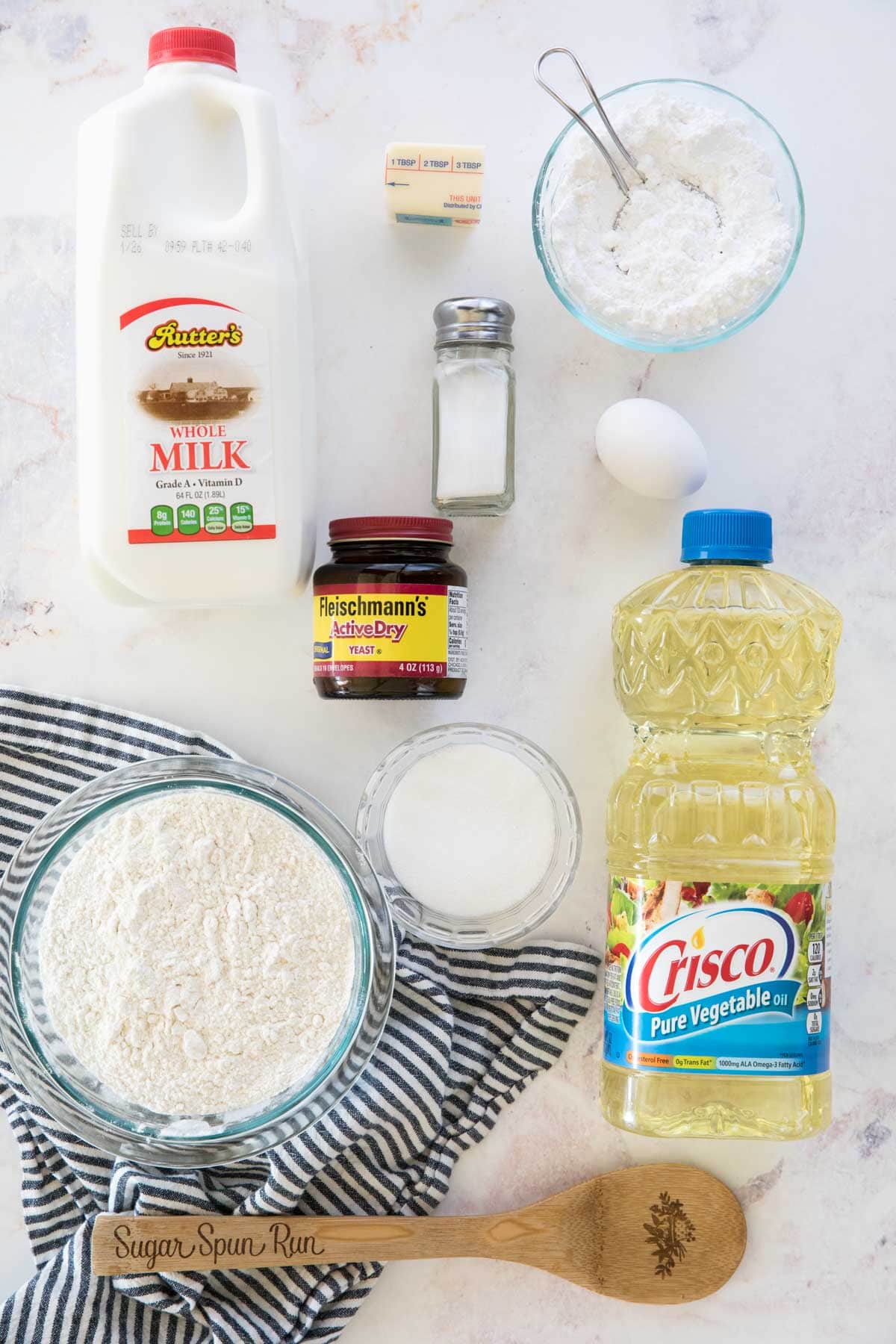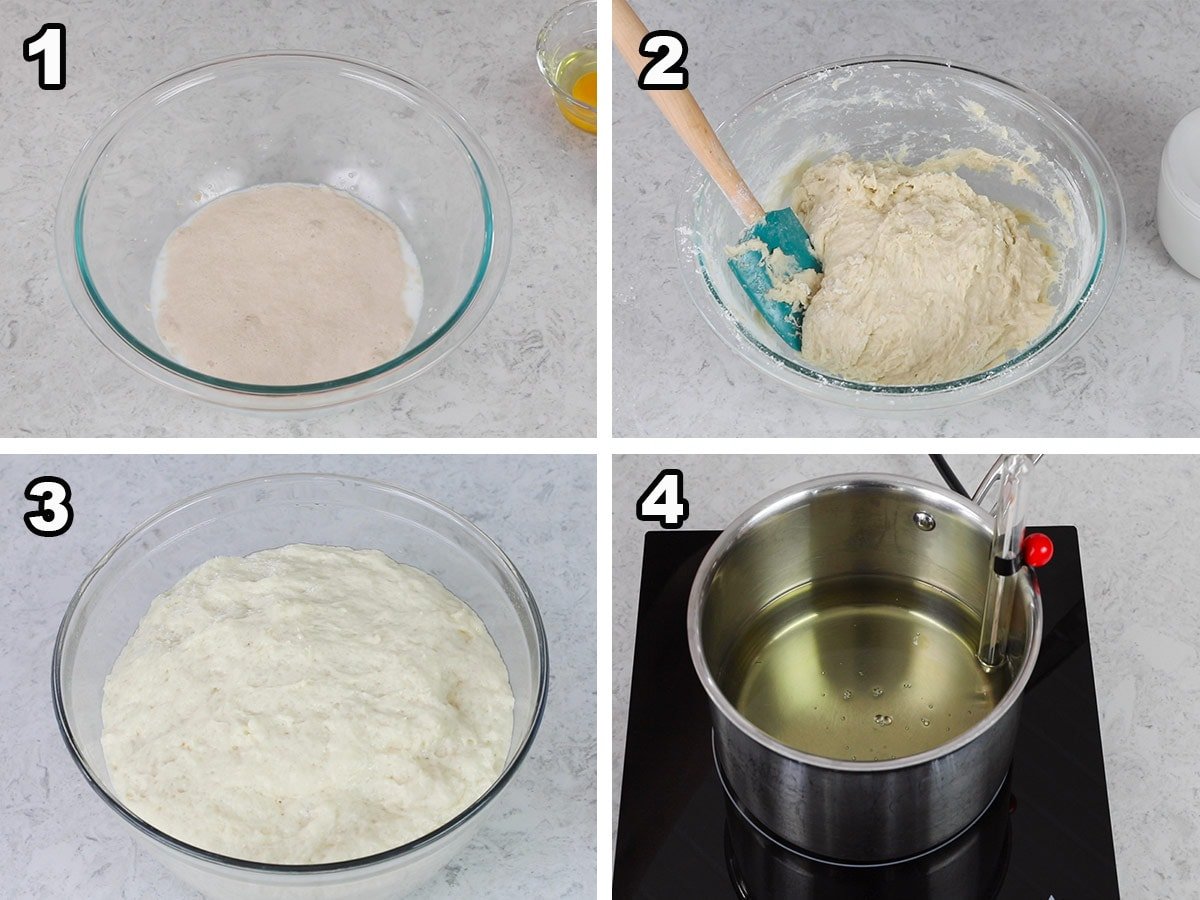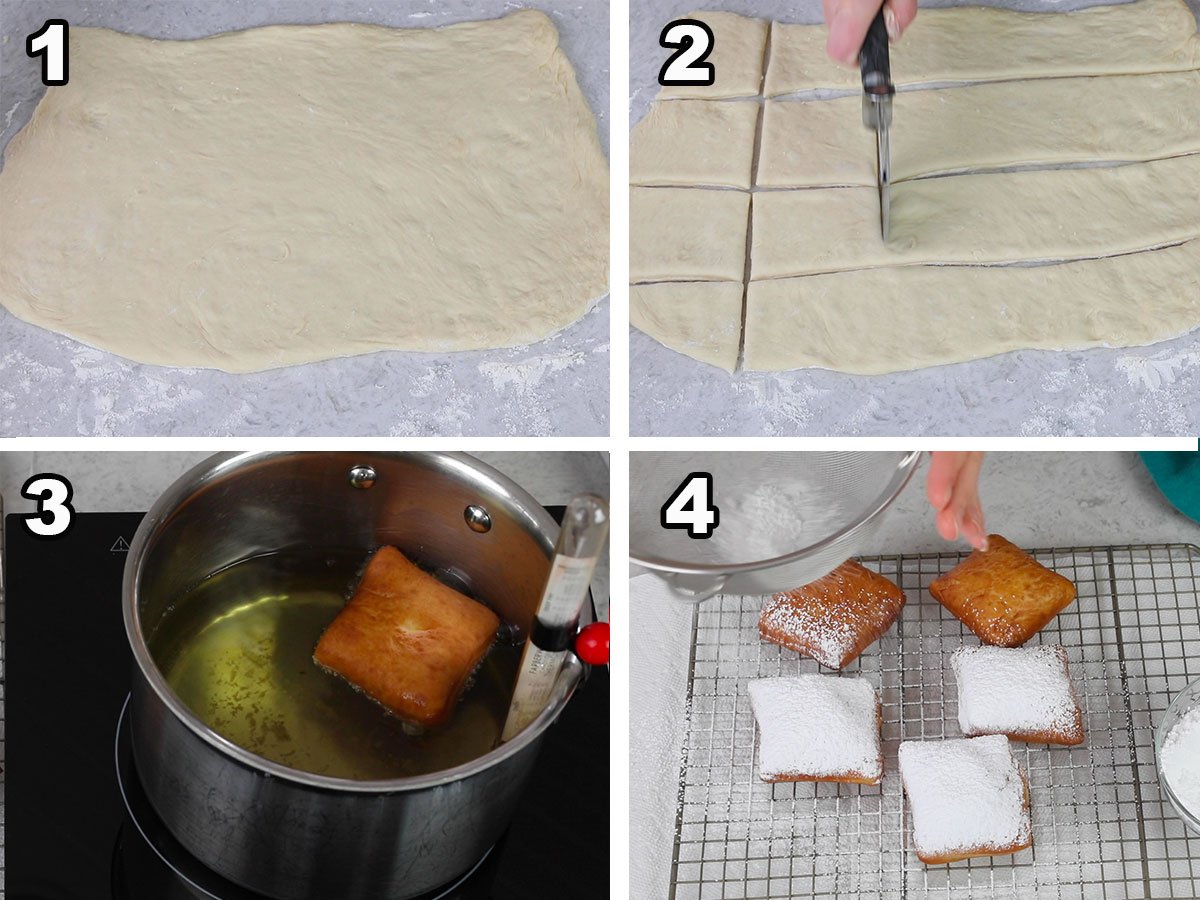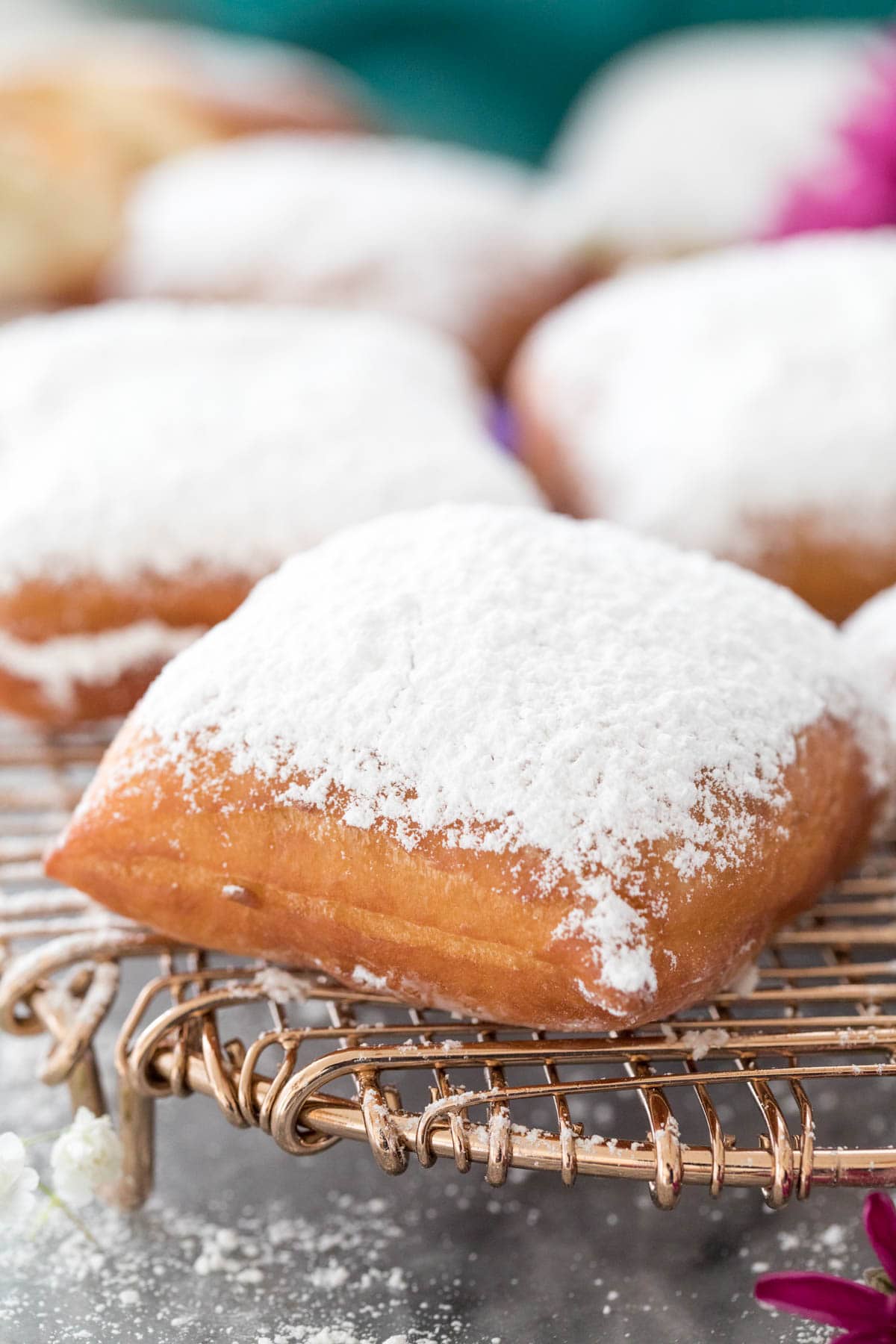My pillowy-soft Beignets are made New Orleans-style, meaning they’re fluffy, melt-in-your-mouth and buried beneath an avalanche of powdered sugar. They’re surprisingly simple to make, too, no deep fryer required!

The Best Beignet Recipe
With Mardi Gras right around the corner I thought it might be a good time to share my easy to make and impossible to resist beignet recipe!
When making beignets (pronounced “ben-YAYs”), there are two different ways you can go about it, the traditional French way or the New Orleans way.
Traditional French beignets are made with pâte à choux (AKA, the base used for gougeres and to make the shells for my cream puffs and eclairs). While it’s unsurprising that the beignets of New Orleans stem from the same French roots, instead of being made steam-raised with choux pastry they’re instead made with a yeast-raised dough that’s very similar to a donut (only airier).
Choux pastry has its place in my life, but I much prefer the fluffier, pillowy-soft, yeast-raised New Orleans-style Beignets, and this is what I modeled my version after. Let’s get started.
What You Need for Beignets

Beignets use basic, easy-to-find ingredients, and I just want to briefly touch on a few of them…
- Milk. I recommend whole milk, it adds fat to the dough which in turn adds fluffy, tender, melt-in-your-mouth-ness to the beignets. However, if you don’t have any you may substitute 2% milk.
- Yeast. I recommend using active dry yeast, but see my FAQ section for notes on making with instant.
- Sugar. Only small bit of granulated sugar goes into the dough, much of the sweetness comes from a flurry of powdered sugar that you’ll add to the golden brown beignets after frying.
- Flour. All-purpose flour or bread flour will work well. I used all-purpose for the beignets in these photos and in the video.
- Oil. You’ll need a neutral oil to fry the beignets. Vegetable oil is my preference, but canola or peanut oil would also work.
Remember, this is just an overview of the ingredients I used and why. For the full recipe please scroll down to the bottom of the post!
How to Make Beignets (the New Orleans Way!)

- First, proof the yeast. Heat your water and milk so that it’s warm but not too hot (between 105 & 115F). A pinch of sugar helps to get things moving faster. If your yeast does not look like mine does in the photo after 10 minutes (15 max!) you’ll need to toss it and start over (see my FAQ section).
- Add remaining ingredients and stir until combined. This dough doesn’t require kneading or isn’t terribly fussy, which isn’t something that can be said for many yeast doughs!
- Place in a large oiled bowl, cover with plastic wrap, and let it rest until doubled in size.
- When dough has risen, begin to heat your oil. Heat over medium heat, this will take some time (do not rush it! heating oil too fast can cause beignets that are overcooked on the outside and undercooked on the inside and can even degrade the taste of the oil.).
Once the dough has risen and your oil is warming the fun frying can begin.

- Turn out the dough onto a lightly floured surface and roll or pat it into a rectangle that’s approximately 12×14″ (the dough should be between ¼-1/2″ thick).
- Cut the dough into squares that are approximately 2.5″ wide (a pizza cutter makes quick and easy work of this).
- Fry beignets on each side until beautiful golden-brown in color.
- Remove to a cooling rack and dust generously with powdered sugar. We don’t mess around with the sugar here at Sugar Spun Run.
Enjoy warm! They are so good fresh, nothing compares!

Frequently Asked Questions
Yes, you can substitute instant yeast for the active dry that is called for.
Either the yeast is expired/dead or the milk/water was heated above the required temperature range (killing the yeast on contact) or it wasn’t heated enough (so it wasn’t warm enough to activate it.
Also, make sure you didn’t accidentally add salt to your yeast mixture instead of the sugar that I call for to speed things along (or maybe I’m the only one who’s ever made that mistake 😳).
Regardless of the cause, if your yeast doesn’t proof you’ll need to toss it out and start over.
Yeast dough can be temperamental when it comes to precisely how much flour to add. If you’re trying to roll out your dough and it’s just too sticky, simply add more flour to your counter surface and to the surface of the dough until it’s easy to handle.
This is usually a sign of an over-ambitious oil-heater or someone trying to get away without using a thermometer (not impossible to do, just tricky!). Typically if the beignets look perfectly golden on the outside but are raw on the inside it’s due to the oil being too hot. Make sure the oil is at a steady 375F
Another oil temperature issue! Often this is caused by oil that is too cold. Make sure you are letting it get back to temperature between batches of beignets.
Yes! Make the beignet dough and let it rise, deflate and cut into squares as instructed. Keep these stored in an airtight container in the refrigerator for up to two days before frying.
I wanted to address this question since I know I’ll be asked it in the comments. I haven’t yet tested baking beignets myself but I think these would be fine if baked, albeit more dense and less pillowy, and certainly less golden.
First person who tries it and lets me know how it turned out for them in the comments gets a gold star (I’m thinking a 350 bake time would be ideal).

More Recipes You Might Like
Enjoy!
Let’s bake together! Make sure to check out the how-to VIDEO in the recipe card!

Beignets
Ingredients
- ½ cup (118 ml) whole milk
- ½ cup (118 ml) water
- 2 ½ teaspoons active dry yeast
- ¼ cup (50 g) granulated sugar
- ¾ teaspoon salt
- 3 Tablespoons unsalted butter melted
- 1 large egg lightly beaten (room temperature preferred)
- 3 ½ cups (438 g) all-purpose flour divided, plus more as needed
- Avocado, vegetable or canola oil for frying (any neutral cooking oil will work)
- 1 cup (125 g) powdered sugar for dusting
Recommended Equipment
Instructions
- Combine water and milk in a heatproof container and heat in the microwave in 20-second intervals until it has reached a temperature between 105-115F (40-46C). Always stir before checking the temperature!½ cup (118 ml) whole milk, ½ cup (118 ml) water
- Pour liquid into a large mixing bowl. Add yeast and about 1 teaspoon of your sugar and stir. Allow to sit until foamy, about 5-10 minutes¹.2 ½ teaspoons active dry yeast, ¼ cup (50 g) granulated sugar
- Once mixture is foamy, add remaining sugar, salt, melted butter and egg and 2 cups (250g) of flour. Stir well. Add remaining flour, stirring until combined.¾ teaspoon salt, 3 Tablespoons unsalted butter, 1 large egg, 3 ½ cups (438 g) all-purpose flour
- Transfer the dough into a large, lightly oiled bowl and cover. Allow to rise in a warm, draft-free place until doubled in size (about 1-2 hours).
- Fill a medium-sized saucepan about 2-3” deep with oil. Fix a thermometer to the pan (make sure the tip is suspended in the oil and not touching the bottom) and turn heat to medium. Keep an eye on the oil, you want to heat it to 375F (190C). This should take approximately 15 minutes.Avocado, vegetable or canola oil
- Meanwhile, lightly dust a clean surface with flour and roll the dough into a rectangle that’s ¼-½” (0.6-1.3cm) thick (about a 12×14” rectangle).
- Use a pizza cutter or knife to cut into squares that are approximately 2.5” (6.5cm) wide.
- Once oil has reached temperature, fry beignets 2 at a time by gently lowering into oil with a spider strainer or with tongs. Cook about 1 ½ minutes on each side or until golden brown.
- Carefully remove from oil and transfer to a cooling rack. Wait for oil to get back to proper temperature before frying next batch of beignets.
- Cool beignets several minutes then dust generously with powdered sugar and serve.1 cup (125 g) powdered sugar
Notes
Instant yeast:
You may substitute instant yeast, if so you will not need to proof the yeast. To do this, combine yeast, sugar, salt, and half the flour and then add the warmed milk and water and stir well, then stir in butter, then egg, then stir in remaining flour as needed.Making in Advance:
You can prepare the dough, let it rise, cut it into squares and then store squares in the refrigerator in an airtight container to fry 1-2 days later.Nutrition
Nutritional information is based on third-party calculations and should be considered an estimate only. Actual nutritional content will vary based upon brands used, measuring methods, cooking method, portion sizes, and more.






Audwrld
I made these for the SECOND time and let me tell you the family said ” They were PERFECT ”
If you made them CORRECTLY, they are the perfect Beignets!!!!
Emily @ Sugar Spun Run
So glad they were such a hit for you again! Thanks for the review 🩷
Cindy
These aren’t beignets. They’re square doughnuts.
Sam
Hi Cindy! This is incorrect. While beignets and donuts do have similarities, they differ in more than just their shape. Beignets are lighter and airier and this recipe reflects that 🙂
Tori
I’ve made this recipe countless times! Crowd favorite.
Sam
I’m so glad everyone enjoys them so much, Tori! 🙂
Eli
They turned out great! And if anyone else has someone who can’t eat fried foods like me, you can bake them pretty quickly just make sure you add a vessel of water for steam and bake at 375 and flip after a few minutes. They are slightly denser but still delicious.
Emily @ Sugar Spun Run
We’re so happy you enjoyed them 😊
Lauren
I baked these and they turned out PERFECT! 10-12 minutes at 350F (which converted to 325 in my convection oven). I brushed them with milk before I put them in the oven, and brushed them with melted butter when they came out (and sprinkled with icing sugar of course). They aren’t AS delicious as deep frying (obviously)…. But still pillowy soft inside and my kiddos ate them up. I used bread flour which I highly recommend for all yeast recipes if you have it on hand!
Sam
I’m so glad you enjoyed them so much, Lauren! Thank you so much for the feedback baking them. 🙂
Betsabé Valor
I made them today and everybody loved them at home! Also, very easy recipe. I will make them again, definetely!
Emily @ Sugar Spun Run
We’re so glad they were a hit! Thanks for giving them a shot, Betsabé 😊
Story
I didn’t have enough oil, so I melted coconut oil, made a thin layer of oil over my dough and put them in an air fryer for 5 minutes at 370 F, But the bottom was not cooked fully so I flipped them over and started it for another three minutes and they came out great!
Vuyiswa
I just tried these and oh my word, this is the best recipe! It’s my first time making or having beignets (not too commonplace in South Africa) and I’m so pleasantly stunned. Mine did not turn out as pillowy, no idea why but they still taste amazing.